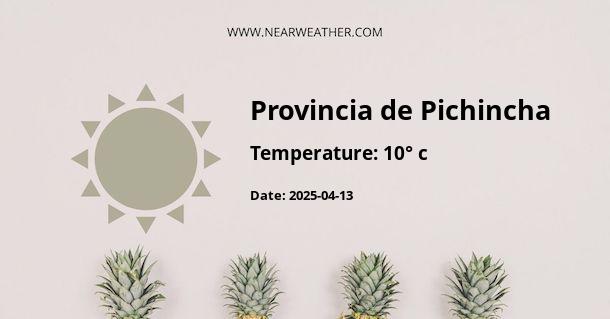Climate and Weather in Provincia de Pichincha, Ecuador
The climate of Provincia de Pichincha, located in north-central Ecuador, is greatly influenced by its diverse topography, which ranges from high Andean peaks to the lower elevations of the Amazon rainforest. The region experiences a wide variety of microclimates, with weather patterns varying significantly based on altitude and proximity to the equator. Understanding the climate and weather patterns in Provincia de Pichincha is essential for residents, travelers, and businesses operating in the area.
Annual Weather Overview
Provincia de Pichincha experiences a characteristic subtropical highland climate due to its varying altitudes. The area has distinct wet and dry seasons, with a generally mild and temperate climate year-round. The highland region is characterized by moderate temperatures, while the lowland areas are typically warmer and more humid.
Temperature
The temperatures in Provincia de Pichincha vary based on altitude. In the capital city of Quito, which is located at an elevation of approximately 9,350 feet (2,800 meters) above sea level, the average annual temperature is around 64.4°F (18°C). However, temperatures can fluctuate significantly throughout the day due to the city's elevation and proximity to the equator.
At lower elevations within the province, such as in the town of Nanegalito in the western lowlands, temperatures can reach an average high of 86°F (30°C) and an average low of 64.4°F (18°C) throughout the year.
Rainfall
The rainy season in Provincia de Pichincha typically occurs from October to May, with the heaviest rainfall experienced in the months of March and April. The highland areas receive an annual average of 40 to 60 inches (1,000 to 1,500 millimeters) of rainfall, while the lowland regions can experience significantly higher amounts, reaching up to 120 inches (3,000 millimeters) annually.
Seasonal Variations
The distinct wet and dry seasons in Provincia de Pichincha greatly impact the region's climate and weather patterns. Understanding these seasonal variations is crucial for planning outdoor activities, agriculture, and tourism in the area.
Dry Season
The dry season in Provincia de Pichincha typically spans from June to September. During this period, the region experiences lower precipitation levels, making it an ideal time for outdoor adventures and tourism. The clear skies and mild temperatures in the highland areas attract visitors seeking to explore the Andean landscapes and indigenous markets.
Wet Season
The wet season, which occurs from October to May, brings abundant rainfall to the region, especially in the lowland areas. This period is essential for the region's agriculture, as the rain nourishes the fertile soils and sustains the lush vegetation of the Amazon rainforest. However, the heavy rainfall can also lead to flooding and landslides in some parts of the province.
Mitigating Weather Risks
Due to the diverse climate and weather patterns in Provincia de Pichincha, it is essential for residents and businesses to prepare for potential weather-related risks. Understanding the seasonal variations and being proactive in implementing mitigation strategies can help minimize the impact of extreme weather events.
Flooding and Landslides
The wet season poses an increased risk of flooding and landslides, particularly in the lowland areas of Provincia de Pichincha. Residents and businesses in flood-prone areas should be aware of evacuation routes and have emergency preparedness plans in place to ensure the safety of the community.
Agricultural Considerations
Agricultural activities in the region are heavily influenced by the seasonal rainfall patterns. Farmers and agricultural businesses should carefully plan their planting and harvesting schedules to optimize crop yields while minimizing the impact of excessive rainfall on their agricultural operations.
Conclusion
Provincia de Pichincha in Ecuador offers a rich tapestry of climate and weather patterns, ranging from the cool highland temperatures of Quito to the warm and humid lowland areas of the province. Understanding these diverse weather patterns is essential for residents, travelers, and businesses to effectively navigate the region's climate and mitigate potential weather-related risks.
By recognizing the seasonal variations and implementing appropriate mitigation strategies, the community of Provincia de Pichincha can harness the benefits of its unique climate while effectively managing the challenges posed by extreme weather events.
A - Provincia de Pichincha's Latitude is -0.083330 & Longitude is -78.500000.
A - Weather in Provincia de Pichincha is 10° today.
A - Climate Conditions in Provincia de Pichincha shows light rain today.
A - Humidity in Provincia de Pichincha is 100% today.
A - Wind speed in Provincia de Pichincha is 0 km/h. today.
